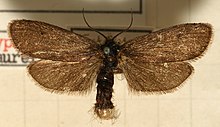| Lypusidae | |
|---|---|

| |
| Lypusa maurella | |
| Scientific classification | |
| Domain: | Eukaryota |
| Kingdom: | Animalia |
| Phylum: | Arthropoda |
| Class: | Insecta |
| Order: | Lepidoptera |
| Infraorder: | Heteroneura |
| Clade: | Eulepidoptera |
| Clade: | Ditrysia |
| Clade: | Apoditrysia |
| Superfamily: | Gelechioidea |
| Family: | Lypusidae Herrich-Schäffer, 1857 |
| Subfamilies | |
|
See text | |
Lypusidae is an obscure family of moths placed in the superfamily Gelechioidea.
History of classification
[edit]The group was traditionally considered monotypic (containing only the genus Lypusa with two species) and belonging in the primitive moth superfamily Tineoidea. Previous research suggested that Lypusa was so closely related to Amphisbatis – the type genus of the gelechioid subfamily Amphisbatinae (or family Amphisbatidae) – that these groups were merged.[1]
Taxonomy and systematics
[edit]- Lypusinae Herrich-Schäffer, 1857
- Chimabachinae Heinemann, 1870
References
[edit]- ^ Heikkilä, Maria; Kaila, Lauri (2009). "Reassessment of the enigmatic Lepidopteran family Lypusidae (Lepidoptera: Tineoidea; Gelechioidea)". Systematic Entomology. 35: 71–89. doi:10.1111/j.1365-3113.2009.00483.x.
Well, that’s interesting to know that Psilotum nudum are known as whisk ferns. Psilotum nudum is the commoner species of the two. While the P. flaccidum is a rare species and is found in the tropical islands. Both the species are usually epiphytic in habit and grow upon tree ferns. These species may also be terrestrial and grow in humus or in the crevices of the rocks.
View the detailed Guide of Psilotum nudum: Detailed Study Of Psilotum Nudum (Whisk Fern), Classification, Anatomy, Reproduction